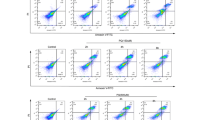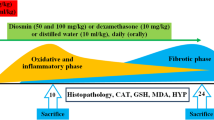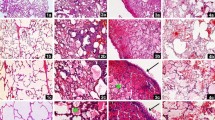Abstract
Acute lung injury (ALI) is a major complication soon after paraquat poisoning and rapidly progresses with high mortality. However, the specific mechanism underlying paraquat-induced ALI is still unclear. In this study, the mechanism underlying the protective effects of SP600125 on paraquat-induced ALI was investigated according to oxidative stress, inflammation, and apoptosis. The rats were randomly assigned into the control group (CON), the paraquat poisoning group (PQ), and the PQ + SP600125 group (SP). A549 cells were divided into the Con group, Pq group, and Sp group. H&E staining and detection of lung wet/dry ratio were employed to evaluate lung injury. Annexin V-PI staining was done to evaluate A549 cell apoptosis. Dihydroethidium fluorescence was used to measure reactive oxygen species (ROS) in the lungs and A549 cells. ELISA was performed to detect TNF-α and IL-6 in the supernatant of bronchoalveolar lavage fluid (BALF) and A549 cells. RT-qPCR was done to measure the messenger RNA (mRNA) expression of TNF-α and IL-6 in the lungs and A549 cells. Western blotting assay was performed to detect the protein expression of phospho-JNK, total JNK, and cleaved caspase-3. Electrophoretic mobility shift assay was employed to detect the DNA binding activities of AP-1 and P-p65. JNK inhibitor SP600125 reduced JNK phosphorylation, downregulated cleaved caspase-3 protein level, decreased AP-1 transcriptional activity and ROS level, and reduced the transcription and expression of TNF-α and IL-6, which improved ALI and cell apoptosis after paraquat poisoning. Our results indicate that JNK/AP-1 mediates ALI as well as oxidative stress and inflammation deterioration secondary to paraquat poisoning.








Similar content being viewed by others
References
Dinisoliveira, R.J., J.A. Duarte, A. Sáncheznavarro, et al. 2008. Paraquat poisonings: mechanisms of lung toxicity, clinical features, and treatment, critical Reviews in Toxicology. Informa Healthcare. Critical Reviews in Toxicology 38 (1): 13.
Gawarammana, I.B., and N.A. Buckley. 2011. Medical management of paraquat ingestion. British Journal of Clinical Pharmacology 72 (5): 745–757.
Slade, P. 2006. The fate of paraquat applied to plants. Weed Research 6 (2): 158–167.
Dodge, A.D. 1971. The mode of action of bipyridylium herbicides, paraquat and diquat. Endeavour 30 (111): 130.
Hoet, P.H., C.P. Lewis, M. Demedts, et al. 1994. Putrescine and paraquat uptake in human lung slices and isolated type II pneumocytes. Biochemical Pharmacology 48 (3): 517–524.
Bird, C.L., and A.T. Kuhn. 1981. Electrochemistry of the viologens. Chemical Society Reviews 10 (1): 49–82.
Rd, R.J., S. Horowitz, W.R. Franek, et al. 2003. MAPK pathways mediate hyperoxia-induced oncotic cell death in lung epithelial cells. Free Radical Biology & Medicine 35 (8): 978–993.
Kim, Y.R., I.K. Kim, S.H. Seo, et al. 2010. Effect of toluene on RANTES and eotaxin expression through the p38 and JNK pathways in human lung epithelial cells. Molecular & Cellular Toxicology 6 (4): 344–350.
Liu, Z., Y. Wang, H. Zhao, et al. 2013. CB2 receptor activation ameliorates the proinflammatory activity in acute lung injury induced by paraquat. BioMed Research International 2014 (2): 971750.
Liu, Z., M. Zhao, Q. Zheng, et al. 2013. Inhibitory effects of rosiglitazone on paraquat-induced acute lung injury in rats. Acta Pharmacologica Sinica 34 (10): 1317–1324.
Mikawa, K., K. Nishina, Y. Takao, et al. 2003. ONO-1714, a nitric oxide synthase inhibitor, attenuates endotoxin-induced acute lung injury in rabbits. Anesthesia & Analgesia 97 (6): 1751–1755.
Wu, N., H. Shen, H. Liu, et al. 2016. Acute blood glucose fluctuation enhances rat aorta endothelial cell apoptosis, oxidative stress and pro-inflammatory cytokine expression in vivo. Cardiovascular Diabetology 15 (1): 109.
Mohammadi-Bardbori, A., and M. Ghazi-Khansari. 2008. Alternative electron acceptors: proposed mechanism of paraquat mitochondrial toxicity. Environmental Toxicology and Pharmacology 26 (1): 1–5.
Raman, M., W. Chen, and M.H. Cobb. 2007. Differential regulation and properties of MAPKs. Oncogene 26 (22): 3100.
Pei, Y.H., X.M. Cai, J. Chen, et al. 2014. The role of p38 MAPK in acute paraquat-induced lung injury in rats. Inhalation Toxicology 26 (14): 880.
Seo, H.J., S.J. Choi, and J.H. Lee. 2014. Paraquat induces apoptosis through cytochrome C release and ERK activation. Biomolecules & Therapeutics 22 (6): 503.
Huang, M., Y.P. Wang, L.Q. Zhu, et al. 2015. MAPK pathway mediates epithelial-mesenchymal transition induced by paraquat in alveolar epithelial cells. Environmental Toxicology 31 (11): 1407–1414.
Nakamura, G.L.J.K. 2007. The c-Jun kinase/stress-activated pathway: regulation, function and role in human disease. Biochimica et Biophysica Acta 1773 (8): 1341–1348.
Sabapathy, K. 2012. Role of the JNK pathway in human diseases. Progress in Molecular Biology & Translational Science 106: 145.
Cho, I.K., M. Jeong, A.S. You, et al. 2015. Pulmonary proteome and protein networks in response to the herbicide Paraquat in rats. Journal of Proteomics & Bioinformatics 08 (5): 67–79.
Davies, C., and C. Tournier. 2012. Exploring the function of the JNK (c-Jun N-terminal kinase) signalling pathway in physiological and pathological processes to design novel therapeutic strategies. Biochemical Society Transactions 40 (1): 85.
Bogoyevitch, M.A., and P.G. Arthur. 2015. Inhibitors of c-Jun N-terminal kinases: JuNK no more? Biochimica et Biophysica Acta 58 (1): 72–95.
Davis, R.J. 2000. Signal transduction by the JNK group of MAP kinases. Cell 103 (2): 239.
Repici, M., R. Wehrlé, X. Antoniou, et al. 2011. C-Jun N-terminal kinase (JNK) and p38 play different roles in age-related Purkinje cell death in murine organotypic culture. The Cerebellum 10 (2): 281–290.
Hui, S.L., H.J. Kim, S.M. Chang, et al. 2004. Inhibition of c-Jun NH 2-terminal kinase or extracellular signal-regulated kinase improves lung injury. Respiratory Research 5 (1): 23.
LeeS, LeeJ, LeeH, et al(2016) MicroRNA134 mediated upregulation of JNK and downregulation of NFkB signalings are critically involved in Dieckol induced antihepatic fibrosis. J Agric Food Chem64(27).
Meyer, M., R. Schreck, and P.A. Baeuerle. 1993. H2O2 and antioxidants have opposite effects on activation of NF-kappa B and AP-1 in intact cells: AP-1 as secondary antioxidant-responsive factor. EMBO Journal 12 (5): 2005.
Apel, K., and H. Hirt. 2004. Reactive oxygen species: metabolism, oxidative stress, and signal transduction. Annual Review of Plant Biology 55: 373–399.
Finkel, T., and N.J. Holbrook. 2000. Oxidants, oxidative stress and the biology of ageing. Nature 408 (6809): 239–247.
Montgomery, M.R., and D.E. Niewoehner. 1979. Oxidant-induced alterations in pulmonary microsomal mixed-function oxidation: acute effects of paraquat and ozone. Journal of Environmental Science & Health Part C Environmental Health Sciences 13 (3): 205–219.
Nagai, H., T. Noguchi, K. Takeda, et al. 2007. Pathophysiological roles of ASK1-MAP kinase signaling pathways. Journal of Biochemistry & Molecular Biology 40 (1): 1–6.
Chen, K., J.A. Vita, B.C. Berk, et al. 2001. C-Jun N-terminal kinase activation by hydrogen peroxide in endothelial cells involves Src-dependent epidermal growth factor receptor transactivation. Journal of Biological Chemistry 276 (19): 16045.
Wajant, H., K. Pfizenmaier, and P. Scheurich. 2003. Tumor necrosis factor signaling. Cell Death and Differentiation 10: 45–65.
Kim, E.M., H.S. Yang, S.W. Kang, et al. 2008. Amplification of the γ-irradiation-induced cell death pathway by reactive oxygen species in human U937 cells. Cellular Signalling 20 (5): 916–924.
Author information
Authors and Affiliations
Corresponding author
Ethics declarations
Conflict of Interest
The authors declare that they have no conflict of interest.
Funding
This study was funded by Science Foundation of Liaoning Education Department (grant numbers LK201633 and LK201603), Peking Union Medical Foundation-Ruiyi Emergency Medical Research Fund (grant number R2015021), and Provincial Natural Science Foundation of Liaoning (grant number 201602879).
Rights and permissions
About this article
Cite this article
Shen, H., Wu, N., Wang, Y. et al. JNK Inhibitor SP600125 Attenuates Paraquat-Induced Acute Lung Injury: an In Vivo and In Vitro Study. Inflammation 40, 1319–1330 (2017). https://doi.org/10.1007/s10753-017-0575-8
Published:
Issue Date:
DOI: https://doi.org/10.1007/s10753-017-0575-8




